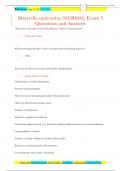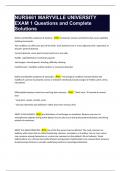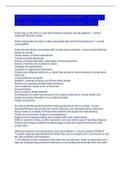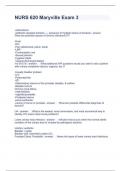Nurs661 exam 3 - Study guides, Class notes & Summaries
Looking for the best study guides, study notes and summaries about Nurs661 exam 3? On this page you'll find 35 study documents about Nurs661 exam 3.
Page 4 out of 35 results
Sort by

-
Maryville university: NURS661: Exam 3 Questions and Answers
- Exam (elaborations) • 20 pages • 2024
-
- $10.49
- + learn more
What area of the brain is most often linked to violence among patients? :-- Prefrontal- cortex Which personality disorder is often associated with self-harming behavior? :-- BPD Know the risk factors associated with suicide among patients :-- Family history of suicide Family history of child maltreatment Previous suicide attempt(s) History of mental disorders, particularly clinical depression History of alcohol and substance abuse Feelings of hopelessness Impulsive or aggr...

-
NURS 661 Exam 2 Full And Revised (Diseases & Disorders) Latest Study Guide Grade A+.
- Exam (elaborations) • 20 pages • 2023
- Available in package deal
-
- $11.99
- + learn more
NURS 661 Exam 2 Full And Revised (Diseases & Disorders) Latest Study Guide Grade A+. Nurs661 Study Guide Exam 2 1. Know different types of anxiety disorders and be able to distinguish between them a. panic disorder: neurotransmitters; serotonin, norepinephrine and GABA. Increased sympathetic tone in the peripheral as well as central NS. Post-synaptic serotonin hypersensitivity; local inhibitory GABA transmission to amygdala, midbrain and hypothalamus. p. 392. Anxiogenic effects of y...

-
NURS661 MARYVILLE UNIVERSITY EXAM 1 Questions and Complete Solutions
- Exam (elaborations) • 16 pages • 2024
- Available in package deal
-
- $13.49
- + learn more
NURS661 MARYVILLE UNIVERSITY EXAM 1 Questions and Complete Solutions Define and identify symptoms of dystonia - Ans: Involuntary muscle contractions that cause repetitive twisting movements. The condition can affect one part of the body- focal dystonia; two or more adjacent parts- segmental; or all parts- general dystonia. Cervical dystonia- cause head to twist and turn to one side. Eyelids- rapid blinking or involuntary spasms Jaw/tongue- slurred speech, drooling, difficulty chewing ha...

-
Maryville university: NURS661: Exam 3 questions well answered latest 2022
- Exam (elaborations) • 9 pages • 2022
- Available in package deal
-
- $12.99
- + learn more
Maryville university: NURS661: Exam 3 questions well answered latest 2022What area of the brain is most often linked to violence among patients? Prefrontal- cortex Which personality disorder is often associated with self-harming behavior? BPD Know the risk factors associated with suicide among patients Family history of suicide Family history of child maltreatment Previous suicide attempt(s) History of mental disorders, particularly clinical depression History of alcohol and...

-
MARYVILLE TEST COMPILATION BUNDLE
- Package deal • 25 items • 2023
-
- $59.99
- + learn more
Exam (elaborations) NURS661 MARYVILLE UNIVERSITY EXAM 1 Questions with correct Answers Exam (elaborations) NURS 620 Maryville Exam 3. Questions with correct Answers Exam (elaborations) NURS 620 Adult 1 Exam 2 Maryville Questions with correct Answers Exam (elaborations) Nurs 615 Pharm Exam 1 Questions Answered 100% correct Exam (elaboration

How much did you already spend on Stuvia? Imagine there are plenty more of you out there paying for study notes, but this time YOU are the seller. Ka-ching! Discover all about earning on Stuvia


